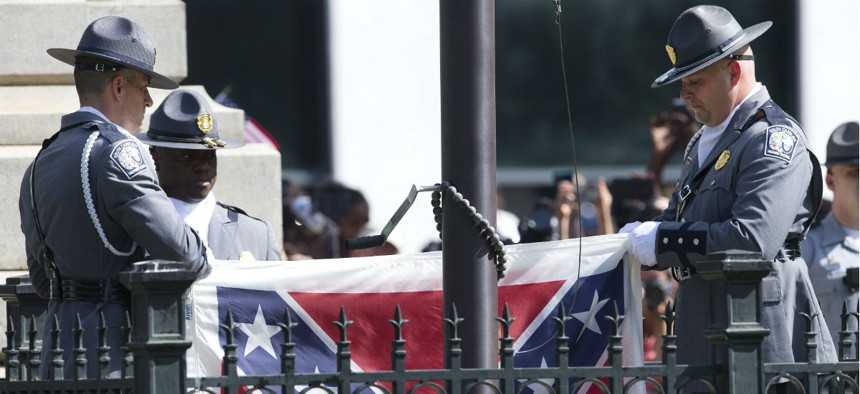
The vote on the bill allowing the pay hike to move forward has been delayed due to a battle over allowing the confederate flag to be displayed in national parks. John Bazemore/AP
Feds’ Pay Raise Takes Unexpected Diversion
Legislation allowing the pay boost to advance gets caught up in political battle.
The fate of next year's across-the-board federal employee pay raise should have become much more clear this week, as House lawmakers had planned a vote on the legislation allowing the pay boost to take effect.
As is often the case with issues important to the federal workforce, however, the bill was derailed due to an unrelated political sideshow. Votes on two appropriations measures were postponed this week after Republicans could not agree on a path forward for a provision allowing the display of the confederate flag at national parks.
That proposal was to be attached to the spending bill covering the Interior Department and related agencies. After taking care of that legislation, the House was scheduled to approve the Appropriations Committee-backed financial services and general government package, the vessel through which lawmakers typically set federal pay policy.
The financial services bill is mum on the 1.3 percent 2016 pay raise proposed by President Obama, which would clear the way for the salary bump to take effect in January. The financial services bill funds the Treasury Department, Executive Office of the President, the Judiciary, District of Columbia, Small Business Administration, General Services Administration, Securities and Exchange Commission and several other independent agencies.
In 2014, Congress also stayed silent on Obama’s proposed pay raise, allowing the 1 percent increase to go into effect. Similar to last year, the bill freezes pay for the vice president and senior political appointees.
If there is no specific legislative language that provides funds or prohibits an across-the-board raise in any bills -- either stand-alone or omnibus legislation -- then the president has the authority to determine a pay raise based on the Employment Cost Index.
The president has until Aug. 31 to formally announce his 2016 pay raise proposal for federal employees. If the president does not inform Congress of his alternative pay plan for feds by that date, then the increase mandated by the 1990 Federal Employees Pay Comparability Act kicks in. Under FEPCA, the raise would be determined by the change in the Employment Cost Index minus 0.5 percent. For 2016, that is around 1.8 percent.
Presidents, however, largely have ignored the FEPCA formula in their federal pay raise proposals, preferring to offer their own figure, which they are allowed to do under law. Congress created FEPCA, which provides an annual across-the-board salary boost and a locality pay adjustment for General Schedule employees, to close the public and private sector pay gap.
The fiscal 2016 spending bills face an uphill climb, even after Congress reschedules their votes. Obama has threatened to veto the Republican-backed measures currently being considered, as they keep in place the reduced funding levels mandated by the 2011 Budget Control Act. Obama has instead insisted lawmakers boost domestic spending and find other ways to offset costs.
To that end, Democrats have called for an agreement similar to that struck by Rep. Paul Ryan, R-Wis., and Sen. Patty Murray, D-Wash., in 2013. That deal, among other things, required new federal employees to contribute more of their salaries toward their retirement pensions.
Congress is set to recess for the entire month of August, and it must reach an agreement to fund agencies by Sept. 30 or the government will shut down. The large gap between congressional Republicans and the White House -- and the limited amount of time to strike a deal -- raises the likelihood of a continuing resolution, which would keep agencies funded at their fiscal 2015 levels until a longer-term solution is reached.
Kellie Lunney contributed to this report.







